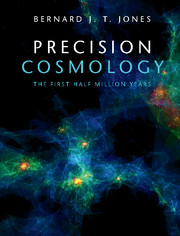Book contents
- Frontmatter
- Dedication
- Contents
- Preface
- Notation and Conventions
- Part I 100 Years of Cosmology
- Part II Newtonian Cosmology
- Part III Relativistic Cosmology
- 10 Minkowski Space
- 11 The Energy Momentum Tensor
- 12 General Relativity
- 13 Space-Time Geometry and Calculus
- 14 The Einstein Field Equations
- 15 Solutions of the Einstein Equations
- 16 The Robertson–Walker Solution
- 17 Congruences, Curvature and Raychaudhuri
- 18 Observing and Measuring the Universe
- Part IV The Physics of Matter and Radiation
- Part V Precision Tools for Precision Cosmology
- Appendix A SI, CGS and Planck Units
- Appendix B Magnitudes and Distances
- Appendix C Representing Vectors and Tensors
- Appendix D The Electromagnetic Field
- Appendix E Statistical Distributions
- Appendix F Functions on a Sphere
- Appendix G Acknowledgements
- References
- Index
17 - Congruences, Curvature and Raychaudhuri
from Part III - Relativistic Cosmology
Published online by Cambridge University Press: 04 May 2017
- Frontmatter
- Dedication
- Contents
- Preface
- Notation and Conventions
- Part I 100 Years of Cosmology
- Part II Newtonian Cosmology
- Part III Relativistic Cosmology
- 10 Minkowski Space
- 11 The Energy Momentum Tensor
- 12 General Relativity
- 13 Space-Time Geometry and Calculus
- 14 The Einstein Field Equations
- 15 Solutions of the Einstein Equations
- 16 The Robertson–Walker Solution
- 17 Congruences, Curvature and Raychaudhuri
- 18 Observing and Measuring the Universe
- Part IV The Physics of Matter and Radiation
- Part V Precision Tools for Precision Cosmology
- Appendix A SI, CGS and Planck Units
- Appendix B Magnitudes and Distances
- Appendix C Representing Vectors and Tensors
- Appendix D The Electromagnetic Field
- Appendix E Statistical Distributions
- Appendix F Functions on a Sphere
- Appendix G Acknowledgements
- References
- Index
Summary
The notion of a curved space-time is sometimes difficult to grasp. One of the ways to understand this is to consider the collection of trajectories, or ‘world lines’, of noninteracting test particles (‘dust’) in an otherwise empty curved space time: a vacuum solution of the Einstein equations. The relationship between neighbouring world lines is distorted by the space-time curvature, i.e. the gravitational field. The trajectories are sensors of the geometry that can be easily visualised.
One of the most important equations of general relativity, the Raychaudhuri equation, was derived by Raychaudhuri (1955, 1957) where he used it to study singularities of solutions to the Einstein equations. The Raychaudhuri equation has played a fundamental part in the study of singularities in general relativity, particularly in 1970s when it was used as a means of describing the geometry of the space-time. Here we derive it and apply it to bring out the nature of the geometry of space-time which is not manifest in the coordinate driven approach that we have followed up to this point.
Geometrical Issues: Space-Time Curvature
In Sections 13.4 and 13.5.2 we discussed the notion of geodesics in a 4-dimensional space-time. The discussion at that point concerned the geometry of a Riemannian manifold at a stage where it was merely endowed with a way of relating different points through a connection: the Christoffel connection. The geodesic in the space time to which we had attached a coordinate system and a metric was given by the important Equation (13.37). The importance of that equation was that it provided a direct link between geodesics in general relativity and particle trajectories in Newtonian theory (Equation 13.47).
The flow of a fluid in 4-dimensional space-time is visualised as the collection of trajectories of the fluid elements in the space-time, the fluid world lines. If the fluid has zero pressure, we call it dust and the fluid elements, or particles in this case, move along trajectories that are geodesics in the underlying space-time manifold. The instantaneous 4-velocity of the particle is a tangent to the trajectory. Locally, at least, there is a hyper-plane perpendicular to the trajectory at each point. In our case of a 4-dimensional space-time, the hyper-plane is a 3-dimensional space, which we refer to as a hyper-plane by analogy with our experience in 3-dimensional Euclidean space.
- Type
- Chapter
- Information
- Precision CosmologyThe First Half Million Years, pp. 411 - 427Publisher: Cambridge University PressPrint publication year: 2017



